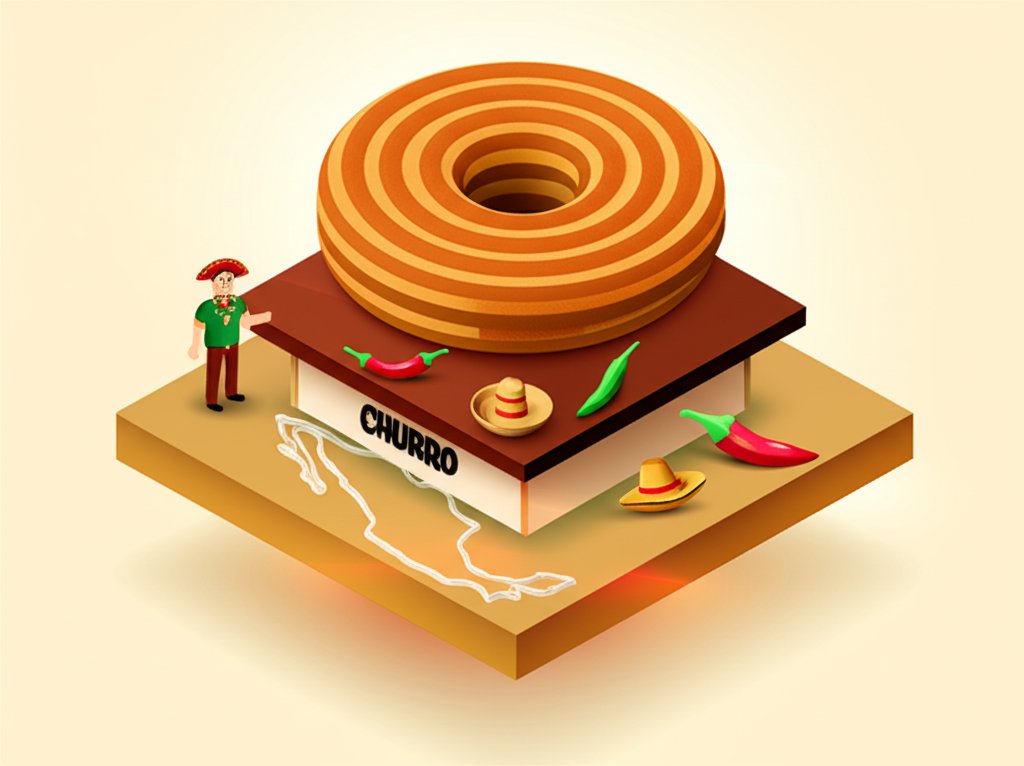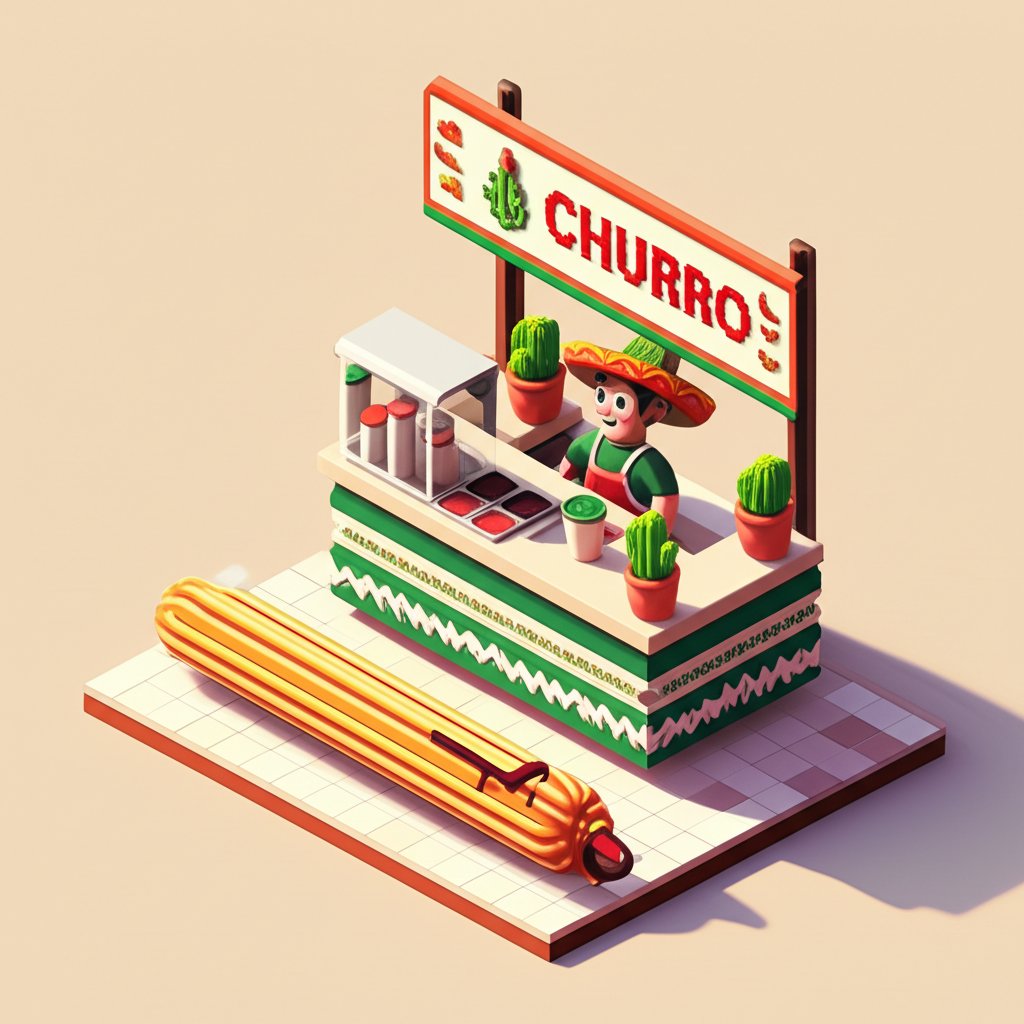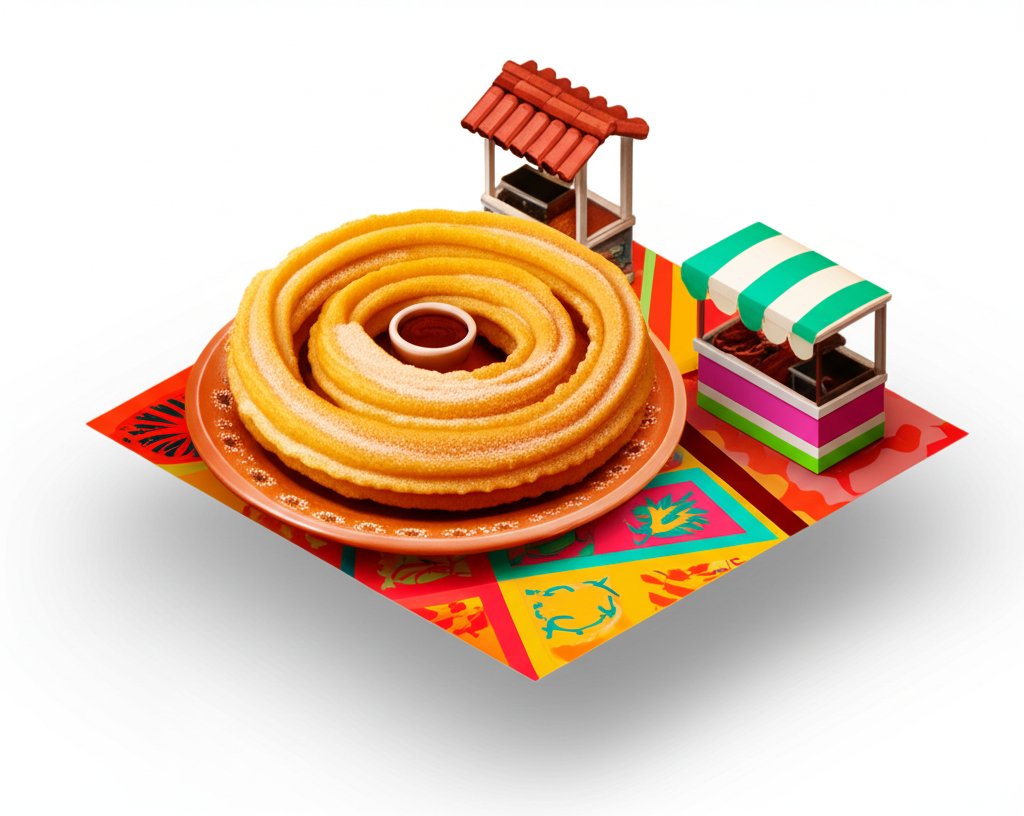Few treats ignite a craving quite like the churro—crispy, warm, and utterly delightful. But as you bite into that sweet, ridged pastry, have you ever paused to ask, “Are churros Mexican?” Or perhaps, “Are churros Spanish or Mexican?” This delicious question has sparked countless debates and culinary explorations.
Prepare to embark on a mouthwatering journey as we unravel the true origins, fascinating evolution, and cultural significance of this beloved fried-dough delight. We’ll explore whether churros are from Mexico initially, delve into the distinct characteristics that differentiate Spanish and Mexican churros, and uncover some truly interesting facts about churros that will deepen your appreciation for this global sensation. Get ready to discover a world where culinary traditions intertwine, creating a sweet legacy enjoyed across continents.
Delving into the rich history of this treat reveals a story much more complex than a simple “yes” or “no,” and you can discover even more about the churro recipe history on our website.
The Sweet Genesis: Are Churros From Mexico? Unpacking Their Spanish Roots

To answer the question “Are churros from Mexico?”, we must first look across the Atlantic to Spain. While deeply ingrained in Mexican culture today, the churro’s journey began centuries ago on the Iberian Peninsula.
Ancient Origins: Shepherd’s Snack or Seafaring Delicacy?
The exact historical pathway of the churro is a subject of charming culinary folklore, offering a few compelling theories:
- The Shepherd’s Theory: One popular tale suggests that churros were invented by Spanish nomadic shepherds. Living high in the mountains without access to bakeries, they needed a readily cooked, easy-to-make, fried dough. The dough could be quickly prepared over an open fire, and its star shape was simple to extrude, preventing the dough from cooking unevenly. The name itself might come from the “Churra” sheep, whose horns resemble the distinct ridges of the pastry.
- The Silk Road Connection: Another theory credits Portuguese sailors with bringing a similar pastry from China. During the Age of Exploration, Portuguese merchants reportedly encountered “YouTiao,” a savory fried dough in China. They adapted it, bringing it back to the Iberian Peninsula where it evolved into the sweet churro we know today, gaining sugar and later, chocolate for dipping.
Regardless of its precise inception, what’s clear is that Spain is the undisputed birthplace of the churro. It was here that this simple, rustic fried dough first captured hearts.
Early Spanish Churros: Simplicity and Tradition
In Spain, churros were, and largely still are, a common breakfast or late-night snack. Traditional Spanish churros are often less sweet than their international counterparts. They are typically:
- Plain and Unadorned: Often served simply dusted with a pinch of sugar, or sometimes plain.
- Thinner and Crispier: Known for their distinct ridged shape, which makes them extra crispy. They can also come in thicker, smoother variations called “porras,” especially in cities like Madrid. Some northern Spanish regions might feature a “lazo” (loop) or knotted churro.
- Dipping-Focused: The true star accompaniment is a thick, rich, hot chocolate for dipping, not drinking. This chocolate is intensely dark and velvety, perfect for coating the crunchy pastry.
These early churros were a testament to simple ingredients – flour, water, and salt – transformed by the magic of hot oil.
A New Home: How Churros Became Mexican Icons
So, if churros originated in Spain, then are churros Mexican food? Yes, absolutely! While not from Mexico originally, churros have been so thoroughly embraced, adapted, and integrated into Mexican cuisine that they are now unequivocally a part of its culinary identity.
The Conquistador Connection: Churros Arrive in the New World
The journey of churros to Mexico began with the Spanish conquistadors and subsequent waves of Spanish immigrants. As Spanish culture, language, and culinary traditions spread across the Americas, the churro came along for the ride. It was a familiar comfort food for the new arrivals and quickly found an appreciative audience among the local populations.
Mexican Ingenuity: Adapting the Classic Treat
What makes a food truly “Mexican” is often its transformation and integration into the vibrant tapestry of local flavors and culinary practices. Churros in Mexico underwent a delightful evolution, moving beyond their simple Spanish roots to incorporate the rich, sweet, and diverse palette of Mexican ingredients.
Mexican artisans and home cooks began to experiment, transforming the humble churro into the diverse and delectable treat we recognize today. This included:
- The Cinnamon-Sugar Coating: Perhaps the most iconic Mexican touch, churros are almost universally rolled in a generous mixture of cinnamon and sugar immediately after frying, creating a fragrant, sweet crust.
- Sweet Fillings: Mexican churros often feature decadent fillings. The most popular include dulce de leche (a rich caramel made from sweetened milk), cajeta (goat’s milk caramel), chocolate, or various fruit jams. These fillings turn the churro from a simple accompaniment into a standalone dessert.
- Diverse Dipping Sauces: While hot chocolate remains popular, Mexican churros are also served with cajeta, lechera (sweetened condensed milk), or chocolate Abuelita (a spiced Mexican hot chocolate).
- Cultural Integration: From bustling street carts (churrerías) and market stalls to high-end restaurants, churros are deeply woven into the fabric of daily life in Mexico. They are enjoyed for breakfast, as an afternoon snack, or as a late-night treat, symbolizing comfort, celebration, and shared joy.
This adaptation and deep cultural embrace mean that while their lineage traces to Spain, the identity of “Mexican churros” is distinct and celebrated in its own right.
Spanish vs. Mexican Churros: Delicious Distinctions and Shared Love
The question, “Are churros Spanish or Mexican?” or “Are churros Mexican or Spanish?” highlights the fascinating differences that have emerged as this beloved pastry traveled and evolved. While both are irresistible fried doughs, their presentation and flavor profiles reveal unique cultural preferences.
The Spanish Style: Crispy, Often Unfilled, and Dip-Ready
Traditional Spanish churros lean towards a more minimalist approach, offering a pure fried dough experience designed to be dunked:
- Shape and Texture: Spanish churros are typically thinner and longer, often with a more pronounced ridged exterior, resulting in a crispier bite. In some regions, you’ll find porras, which are thicker and fluffier, or churros that are looped or knotted.
- Flavor Profile: They are usually made with a simpler dough (flour, water, salt) and are very lightly sugared, or not at all, before being served. The focus is on the dough itself.
- Accompaniment: The quintessential partner for a Spanish churro is a small cup of thick, almost pudding-like, hot chocolate. This isn’t for drinking, but specifically for dipping the churros. Very rarely are Spanish churros filled.
- Serving Time: Commonly enjoyed for breakfast or as an afternoon merienda (snack) at a churrería.
The Mexican Evolution: Sweet Fillings and Flavorful Coatings
Mexican churros, while sharing the same underlying dough concept, have developed a sweeter, more decadent personality:
- Shape and Texture: Mexican churros tend to be slightly thicker and can be either shorter sticks or longer loops, still maintaining a crispy exterior but often a softer, doughier interior, especially when filled.
- Flavor Profile: The defining characteristic is the generous coating of cinnamon sugar applied immediately after frying. This adds a sweet, aromatic layer that is integral to the Mexican churro experience.
- Fillings and Sauces: Mexican churros frequently feature rich, sweet fillings like dulce de leche, cajeta, chocolate, or fruit jams, injected directly into the warm pastry. They are also often served with a side of dipping sauces, including chocolate, cajeta, or sweetened condensed milk.
- Serving Time: Enjoyed throughout the day—for breakfast, lunch, as a dessert after dinner, or a popular street food snack at any hour.
In essence, while the Spanish version showcases the purity of the dough and the richness of the dipping chocolate, the Mexican churro celebrates an explosion of sweetness and a symphony of added flavors and textures. Both, however, are deeply cherished cultural staples in their respective countries.
Beyond Borders: The Global Phenomenon of Churros
The charm of churros is not confined to Spain and Mexico; it has spread far and wide, evolving with local tastes and creating new, exciting variations.
Latin American Variations: From “Churros Locos” to Regional Flavors
Across Latin America, churros have found new expressions:
- Argentina and Uruguay: Here, churros are commonly filled with dulce de leche and are a popular accompaniment to coffee. They can be found in bakeries and cafes.
- Brazil: Known as churros brasileiros, these are often filled with doce de leite (the Brazilian equivalent of dulce de leche) and covered in sugar and cinnamon. Some modern variations even include chocolate or guava paste fillings.
- Colombia: Sometimes served with arequipe (another form of dulce de leche) or cheese.
- Churros Locos: A playful, savory-sweet snack, particularly popular in border regions of Mexico and the US. These often start with industrial “churritos de maíz” (corn snacks shaped like mini churros) and are topped with a wild mixture of hot sauce, lime juice, jícama, cucumber, peanuts, and chili powder. It’s a testament to the versatility of the “churro” concept!
North American Popularity: Festivals, Cafes, and Creative Twists
In the United States and Canada, churros have become a beloved treat, often found at:
- Theme Parks and Fairs: A quintessential snack at amusement parks, carnivals, and county fairs, typically served warm with cinnamon sugar.
- Mexican Restaurants: Many Mexican restaurants offer churros as a dessert, often with chocolate or caramel dipping sauces.
- Specialty Cafes and Food Trucks: Dedicated churrerías and food trucks are popping up, showcasing both traditional and innovative churro creations, including churro ice cream sandwiches, churro sundaes, and churro-flavored beverages.
This global spread demonstrates the churro’s universal appeal as a comforting, versatile, and utterly delicious fried pastry.
Delving Deeper: Interesting Facts About Churros You Didn’t Know

Beyond their origins and cultural adaptations, churros hold a fascinating array of stories and fun details that make them even more intriguing. Here are some interesting facts about churros:
More Than Just a Snack: Cultural Significance and Celebrations
- National Churros Day: While not universally recognized, some regions and enthusiasts celebrate National Churros Day, often on October 18th, highlighting the treat’s cultural importance and encouraging indulgence.
- New Year’s Tradition in Spain: In Spain, it’s common to enjoy churros with chocolate for breakfast on New Year’s Day after a night of festivities. This tradition offers a comforting start to the new year.
- Street Food Staple: In many countries, particularly Mexico and Spain, the sight and smell of a street churrería are an iconic part of city life, bringing communities together over freshly made, hot churros.
Record-Breaking Treats and Culinary Innovations
- The Longest Churro: The record for the longest churro ever made is an impressive feat, reaching over 1,500 feet! This monumental churro was created in Spain, requiring a special frying setup to achieve such scale.
- Churro-Inspired Desserts: The popularity of churros has inspired a wave of creative culinary innovations. You can now find churro ice cream sandwiches, churro waffles, churro cheesecakes, and even churro-flavored cereals.
- Churro-Themed Drinks: The flavor profile of churros has found its way into beverages, with cafes offering churro lattes, churro hot chocolates, and churro milkshakes, capturing the essence of cinnamon and fried dough in liquid form.
The Art of the ‘Churrero’
- Skill and Precision: Making perfect churros, especially the traditional Spanish varieties, requires significant skill. The churrero (churro maker) must master the dough consistency, the pressure of the extruder, and the precise frying temperature to achieve that ideal crispy exterior and tender interior.
- Simple Ingredients, Complex Technique: Despite being made from basic ingredients (flour, water, salt, oil for frying), the process of creating a light, airy, and perfectly cooked churro is an art form honed over generations.
These interesting facts about churros paint a picture of a humble pastry that has transcended its origins to become a global culinary icon, continually inspiring new forms and traditions.
Conclusion: A Delicious Journey, A Shared Heritage
Ultimately, the question, “Are churros Mexican?” leads us to a rich and nuanced answer. While churros are not originally from Mexico, having been born in Spain, they are undeniably a beloved and integral part of Mexican cuisine and culture today. Mexico adopted, adapted, and elevated the churro, infusing it with its own vibrant flavors and turning it into a distinct culinary treasure.
Whether you prefer the crisp, unsweetened Spanish churro dipped in thick chocolate, or the cinnamon-sugar coated, dulce de leche-filled Mexican churro, one thing is clear: churros are a testament to the power of cultural exchange and culinary evolution. They represent a delicious bridge between two worlds, a sweet legacy shared and celebrated.
So, the next time you savor a churro, remember its incredible journey—from the humble fires of Spanish shepherds to the bustling streets of Mexico City and beyond. It’s more than just a sweet treat; it’s a taste of history, culture, and shared human joy.
FAQ: Your Top Questions About Churros Answered
Q1: What is the true origin of churros?
A1: Churros originated in Spain. While the exact story is debated, theories suggest they were created by shepherds or inspired by a Chinese fried dough brought back by Portuguese sailors.
Q2: Are churros from Mexico originally?
A2: No, churros are not originally from Mexico. They were brought to Mexico by Spanish immigrants and conquistadors, who introduced the pastry to the New World.
Q3: Are churros Mexican or Spanish?
A3: Churros have Spanish origins but have become a deeply embedded and uniquely adapted part of Mexican cuisine. So, they are both! Spanish churros are typically plainer, served with thick hot chocolate for dipping, while Mexican churros are often coated in cinnamon sugar and filled with sweets like dulce de leche or chocolate.
Q4: What are the main differences between Spanish and Mexican churros?
A4: Spanish churros are generally thinner, crispier, less sweet, and typically served plain with a side of very thick hot chocolate for dipping. Mexican churros are often thicker, covered in cinnamon sugar, and frequently filled with dulce de leche, chocolate, or fruit jams.
Q5: Are churros considered Mexican food?
A5: Yes, absolutely. While their origin is Spanish, churros have been so thoroughly adopted, adapted with local flavors (like cinnamon sugar and dulce de leche fillings), and integrated into Mexican culture that they are now distinctly recognized and celebrated as a staple of Mexican cuisine.
Q6: What are popular toppings and fillings for Mexican churros?
A6: Mexican churros are famously rolled in cinnamon sugar. Popular fillings include dulce de leche (caramel), cajeta (goat’s milk caramel), chocolate, and various fruit jams. They are also often served with dipping sauces like chocolate or sweetened condensed milk.
Q7: How are Spanish churros traditionally eaten?
A7: Traditional Spanish churros are typically eaten for breakfast or as an afternoon snack (merienda). They are often dipped into a very thick, rich hot chocolate, which is more akin to a dipping sauce than a beverage. They are rarely filled.
Q8: Is there a National Churros Day?
A8: Yes, some regions and churro enthusiasts celebrate National Churros Day, often observed on October 18th, as a way to honor this beloved fried pastry.










